The NVIDIA GeForce GTX 750 Ti and GTX 750 Review: Maxwell Makes Its Move
by Ryan Smith & Ganesh T S on February 18, 2014 9:00 AM ESTOverclocking: When Headroom Exceeds Clockspeed Limits
Last but not least we have our customary look at overclocking performance. With all 3 of our cards being based on the same reference design, we expect to see some relatively consistent results between the cards. At the same time NVIDIA has told us that GTX 750 has some very interesting overclocking properties, and boy they weren’t kidding.
On a quick note, as a GPU Boost 2.0 product, overclocking on the GTX 750 series is not any different than on other GTX 700 series cards. It’s still based on offset overclocking, with the user adjusting offsets for the final overclock. But with that said there are two things to point out. The first is that the power target is limited to 100% on all cards. Because these are sub-75W cards, NVIDIA is not allowing anyone to exceed the card’s default TDP, so you only have as much power to play with as you started with. Second of all, none of our cards had available overvoltage bins. Apparently some cards do, but ours did not, so our voltage bins maxed out at the default bins you see listed.
Finally, all 3 cards have a maximum clock offset of 135MHz. This will be an important fact in a little bit.
| GeForce GTX 750 Series Overclocking | |||||
| GTX 750 Ti (Ref) | Zotac GTX 750 Ti | Zotac GTX 750 | |||
| Shipping Core Clock | 1020MHz | 1033MHz | 1033MHz | ||
| Shipping Max Boost Clock | 1150MHz | 1175MHz | 1163MHz | ||
| Shipping Memory Clock | 5.4GHz | 5.4GHz | 5.0GHz | ||
| Shipping Max Boost Voltage | 1.168v | 1.137v | 1.187v | ||
| Overclock Core Clock | 1155MHz | 1168MHz | 1168MHz | ||
| Overclock Max Boost Clock | 1285MHz | 1310MHz | 1298MHz | ||
| Overclock Memory Clock | 6.3GHz | 6.1GHz | 6.0GHz | ||
| Overclock Max Boost Voltage | 1.168v | 1.137v | 1.187v | ||
As we can quickly see, two patterns emerge. The first is that with every card equipped with 6GHz memory (though we remain unsure which mode the Zotac GTX 750’s is in), each and every card hits at least 6GHz, and sometimes a bit more. With the 128-bit memory bus generally providing the biggest bottleneck for GM107, the fact that there is 12%+ overclocking headroom here is going to be very helpful in feeding the tiny beast that is GM107.
More significantly however is the core overclock. We maxed out every single one. Every card, from the NVIDIA reference card to the Zotac cards, had no trouble overclocking by the full 135MHz to their respective maximum overclocks. The Zotac GTX 750 Ti, having the highest maximum boost clock by default, is technically the winner here at 1310MHz. But at this point everyone is a winner. Going by the maximum boost clock, every card is capable of an 11% core overclock, to go with that tasty 12% memory overclock.
The fact of the matter is that this is not something we normally encounter. Sub-75W cards are not poor overclockers, but they’re not usually strong overclockers either, which is why a 135MHz offset limit makes sense at first glance. But it’s clear that NVIDIA underestimated their own overclocking potential here when setting the specifications for these cards, as there’s seeming some headroom left untapped. Without additional offset room it’s impossible to say just how much more overclocking headroom remains – it may not be very much – but there should be room for at least some additional overclocking.
At this point with cards already in the pipeline we’ll have to take a look at individual cards and see what manufacturers have set their offset limits at. If they have followed NVIDIA’s specifications, then they’ll be equally limited. But hopefully with the launch now behind them, NVIDIA’s partners can work with NVIDIA on making greater offsets available on newer batches of cards.
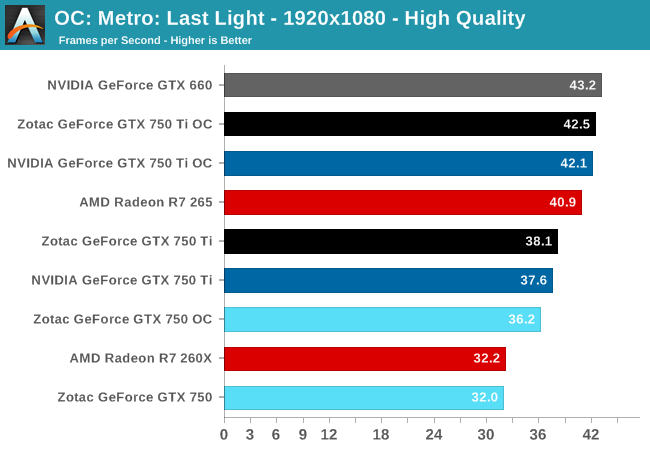
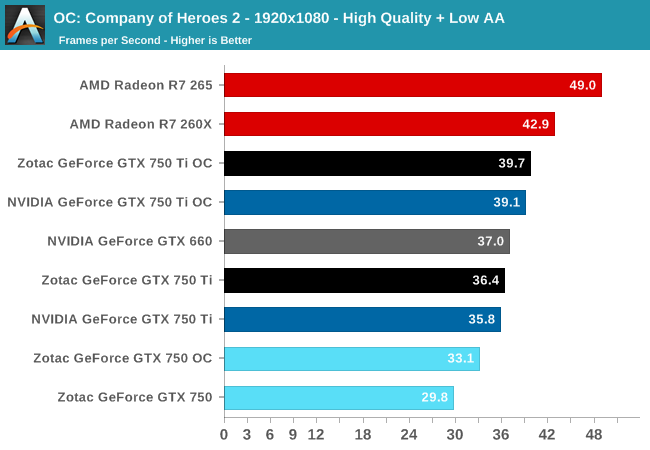
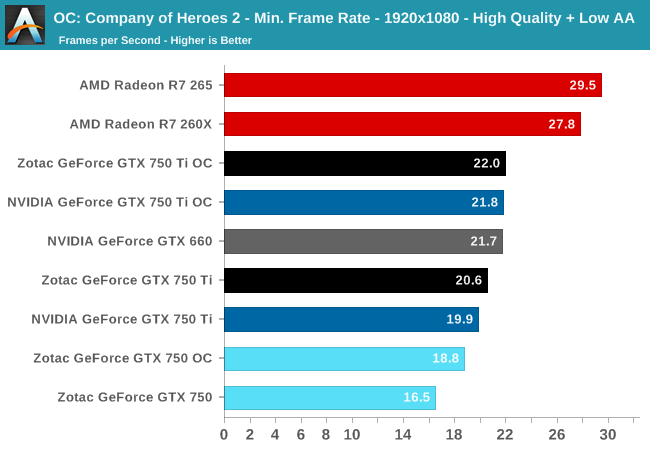

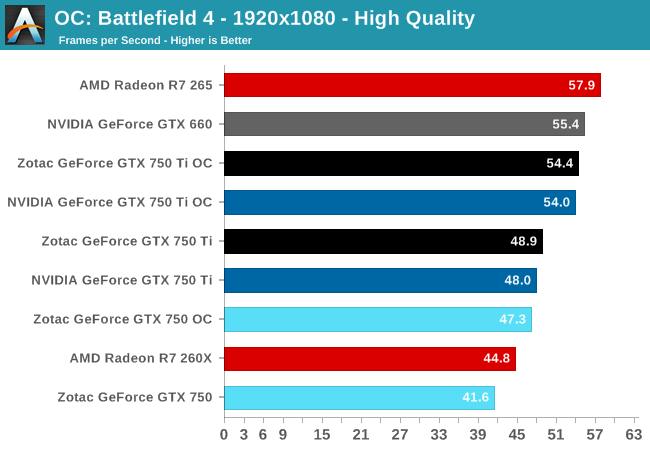
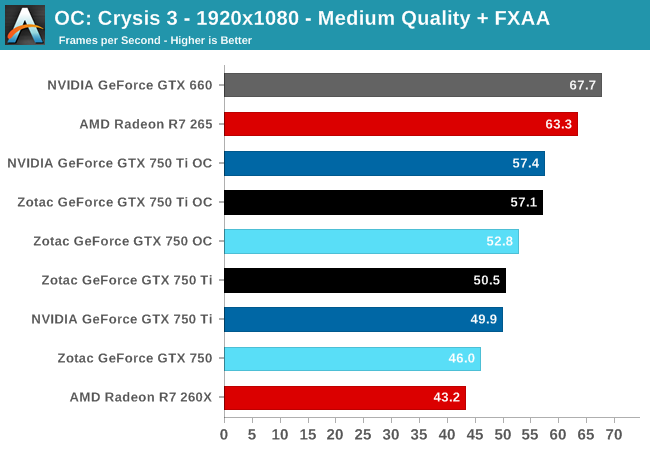
Depending on the game being used, the benefits from overclocking range from 9% to 12%, roughly in-line with our overclocks. For the GTX 750 this is sometimes enough to catch the stock clocked R7 260X, but even with this overclock the GTX 750 Ti will still generally trail the R7 265.
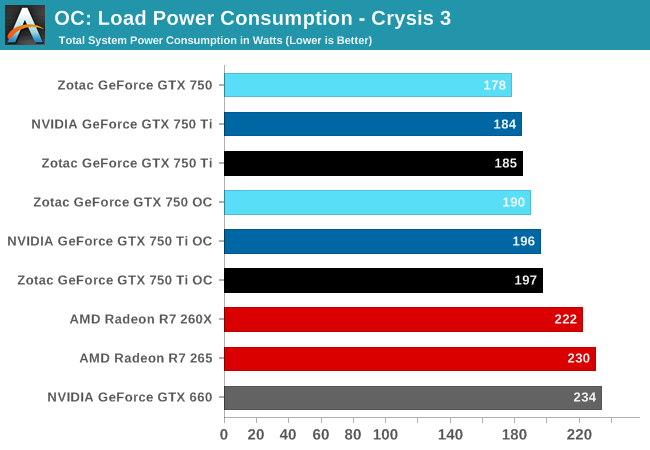

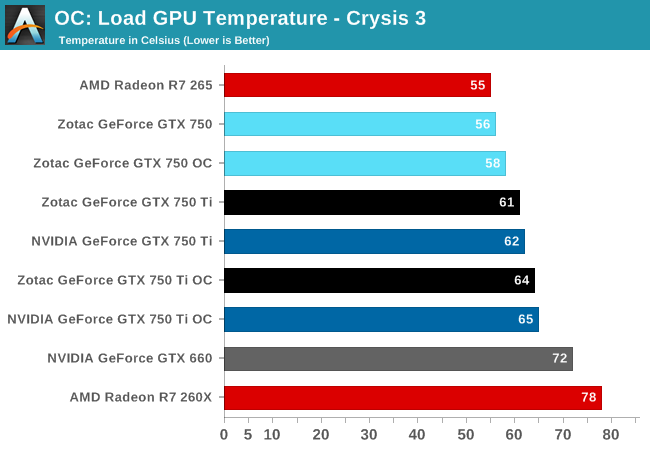
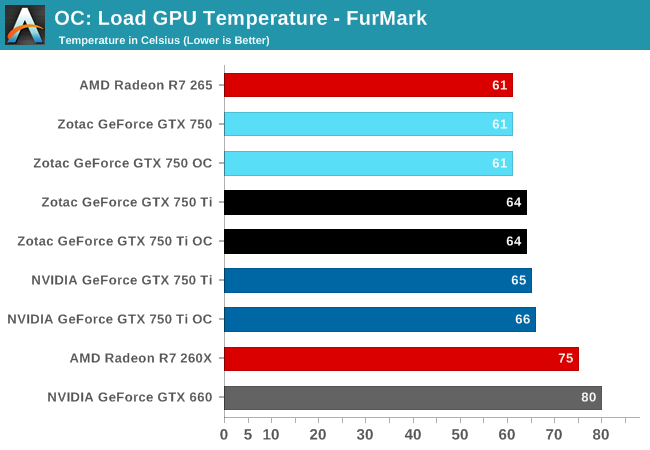
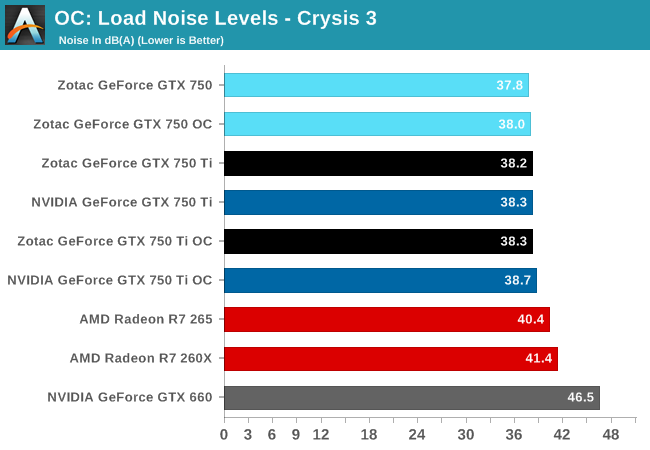
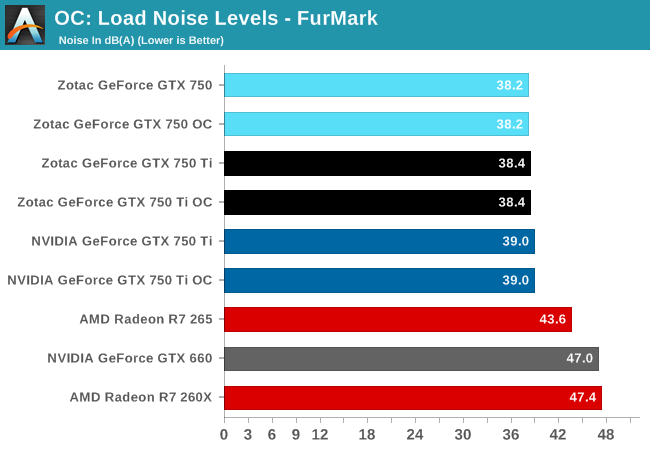
On the other hand, because of the hard TDP limit of 100%, this extra performance is relatively cheap. Video card power consumption moves by only a few watts, and then a few watts of CPU time on top of that. For all practical purposes overclocking can extend NVIDIA’s already incredible performance-per-watt ratio by another 10% with no meaningful impact on noise. Given the consistency of overclocking headroom we’ve seen in our GTX 750 series samples, this is one of those scenarios where overclocking is going to be a reasonable and (relatively) fool proof action to take.










177 Comments
View All Comments
jukkie - Friday, February 21, 2014 - link
I see the GTX 750 Ti as a direct competitor to the HD 7770, so why was AMD's card left out of the list?Hmmm...
Novaguy - Saturday, February 22, 2014 - link
I thought AMD's plan is to put the 7850/r7 265 up against the 750 Ti, not the 7770. The HD 7770 really isn't the direct competitor to the 750 Ti; it's usually had around $110. I would guess that if there's anything the HD 7770 competes against, it would be the upcoming 750.th3parasit3 - Friday, February 21, 2014 - link
I'm still running a GTX460 768MB with an E8500 at stock (built in 2010), mind you my display is only 1650x1050. To me, Maxwell is a huge advancement -- not because of its ability to deliver great FPS at 1080p, but because of its power requirements, or lack thereof.AMD burned me on a faulty 5770, so I have much love for NVIDIAs driver support and performance boosts. Looks like after a four year holding pattern, 2014-15 is the year I upgrade my GPU and rebuild. Sign me up for a 750ti and a 860/870.
Grandal - Saturday, February 22, 2014 - link
These seem to be ready made Steam Box drop-ins to me. Will hit the thermal requirements at the perfect time to win the "reference" Steam Box GPU battle.Novaguy - Saturday, February 22, 2014 - link
Hmm, beyond using this to upgrade my oem boxes from radeon 7750's, I'll love to see this turned into a mid-range mobile card. 750 Ti downclocked for mobile (maybe this is the 850M/860M) would be a nice upgrade over 750M/755M and even possibly even the 760M/765M. It's already below the 75 W TDP those 760M/765M MXM cards call for....Novaguy - Saturday, March 1, 2014 - link
Just broke down and bought a 750 ti to upgrade from a 7750. Really nice, runs really cool. Definitely worth it for those of you who want to upgrade oem boxes without dealing with the psu, especially if you flip the 7750 at the usual places.dr_sn0w - Wednesday, February 26, 2014 - link
So, gurus, please tell me if the GTX 750 ti OC will support 4k resolution or not. Thanks.av30 - Friday, March 7, 2014 - link
I really would have liked to see how the vanilla 750 performed in the HTPC environment in relation to the GT 640. Any chance of updating that section of the review?kamlesh - Wednesday, March 12, 2014 - link
I m realy curious about Tegra K1 and its succsessor... Leave K1 beside for a moment and see if gtx 750 having 512 cuda cores n draws 55W and gtx 750ti having 640 drws 60W then if u calculate maxwell's each cuda (veriably) draw 0.039W(if clocked at 1ghz or abov). Means if next Tegra uses 2smx of maxwell (256 cores) it might use only 4W (CONSIDERING 20NM AND ~600MHZ CLOCK GPU) and and max 5W with entire SoC.Gadgety - Saturday, March 22, 2014 - link
Yep me too. Specially the K1 successor, even though the K1 itself is barely out. GPU per watt likely to yield amazing mobile graphics.